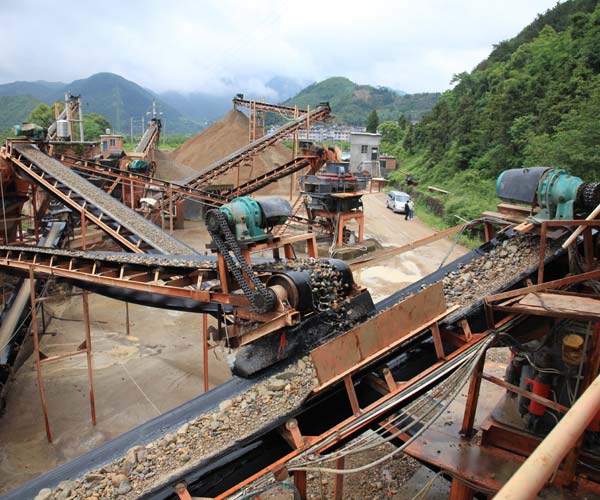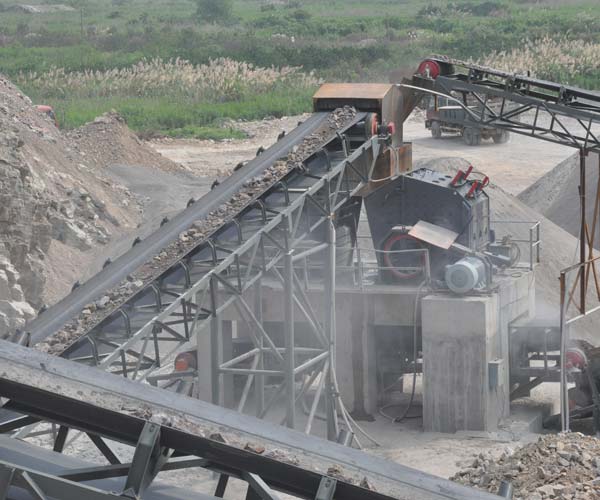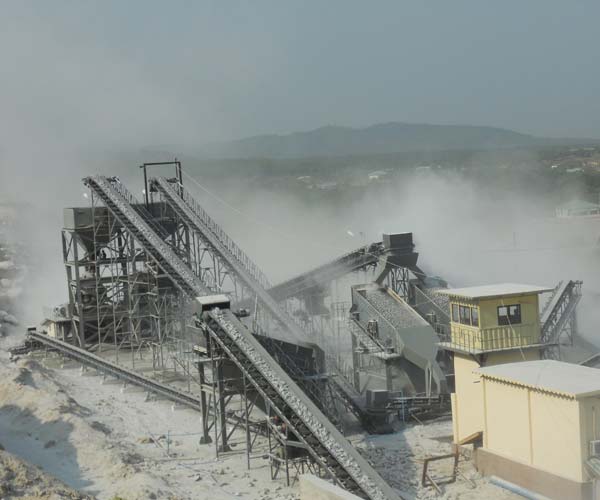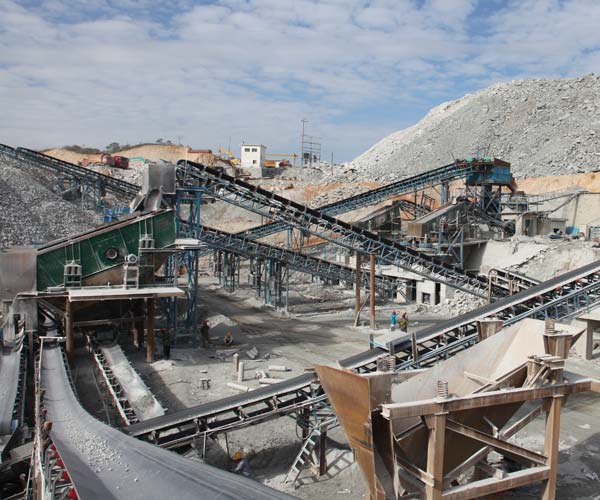
Belt conveyors stand as a testament to human ingenuity in harnessing mechanical principles to streamline material handling processes. Their elegant design, driven by belts, pulleys, rollers, and motors, forms the backbone of industries around the world.
24 Online Service

Among the various tools that facilitate this crucial aspect, belt conveyors have emerged as stalwarts, revolutionizing the way materials are transported within factories, warehouses, mines, and construction sites. With their ingenious design and versatile capabilities, these mechanical marvels have become the backbone of industries dealing with a diverse range of materials, from fine sand to robust crushed stone.
At its core, a belt conveyor is a system designed to transport materials from one point to another in a smooth, continuous motion. This ingenious mechanism hinges on the interplay between a motor-driven belt and a series of pulleys and rollers. The fundamental principle that drives the operation of a belt conveyor is the utilization of frictional force between the belt and the conveyed material, enabling controlled movement. The belt, typically made from various materials like rubber, fabric, or metal, acts as the conveyor’s backbone, carrying the load while traversing the predetermined path.
The choice of belt material depends on the nature of the transported material and the operating conditions. For instance, rubber belts are often preferred for their durability and flexibility, allowing them to adapt to varying loads and conditions. Heavy-duty operations might necessitate steel-cord belts, which provide heightened strength and resistance to impact.
Pulleys serve as the driving force of the conveyor. The head pulley, often powered by an electric motor, propels the belt forward, initiating the material’s journey. The tail pulley guides the returning belt, completing the continuous loop. Intermediate pulleys provide additional support and routing along the conveyor’s path.
Rollers play a vital role in maintaining the alignment and proper tension of the belt. They are strategically positioned along the conveyor’s length and support the belt, reducing friction and ensuring smooth movement. Rollers also assist in minimizing wear and tear on the belt, prolonging its operational life.
The motor is the powerhouse of the conveyor, supplying the necessary energy to propel the belt. Modern conveyors often use electric motors equipped with variable speed drives, allowing operators to adjust the conveyor’s speed according to specific material handling requirements.
One of the most remarkable aspects of belt conveyors is their ability to handle an extensive array of materials, each with distinct properties and handling challenges. From lightweight grains to hefty aggregates like crushed stone, belt conveyors have demonstrated their adaptability across industries:
When it comes to transporting delicate materials like sand or powdered substances, belt conveyors shine. Their smooth, continuous motion ensures minimal disturbance to the material’s structure, preventing breakage or degradation during transport. This makes them indispensable in industries like food processing, where maintaining the integrity of powders or grains is critical.
On the other end of the spectrum, belt conveyors have proved their mettle in handling bulkier materials such as crushed stone, gravel, or construction debris. These conveyors are equipped with robust belts and heavy-duty components to withstand the weight and impact associated with coarse aggregates. Their efficiency in transporting such materials streamlines construction and mining operations, reducing manual labor and boosting productivity.
Belt conveyors have transcended industrial boundaries, finding applications in various sectors including manufacturing, mining, agriculture, and logistics. In manufacturing, they aid in automating production lines by seamlessly moving products from one processing stage to another. In agriculture, they assist in transferring crops or harvested produce for sorting and packaging. In logistics and warehousing, belt conveyors expedite the movement of goods, enhancing supply chain efficiency.

In the ever-evolving realms of construction and mining, innovation continues to be the driving force behind improved efficiency, reduced labor costs, and enhanced safety. These mechanized marvels have transformed the way materials like crushed stone and sand are transported within construction sites and mining operations, offering a host of benefits that have redefined the landscape of these industries.
Belt conveyors are mechanical systems that consist of a continuous loop of moving belts, designed to transport materials from one point to another. In construction and mining, their role in handling various materials cannot be overstated. Whether it’s the movement of gravel, sand, or crushed stone, these conveyors excel at transporting materials efficiently and precisely, ultimately boosting productivity and curbing the need for extensive manual labor.
Construction sites are bustling hubs of activity, where coordination and efficiency are paramount. Belt conveyors play a pivotal role in optimizing these sites by facilitating the smooth movement of materials. Consider a scenario where massive amounts of crushed stone need to be transported from a storage area to the construction site. Manual labor in such cases could be labor-intensive, time-consuming, and subject to errors.
Mining operations involve the extraction of valuable resources from the Earth’s crust, and the logistics of handling mined materials are complex. Belt conveyors have revolutionized the mining industry by streamlining material transportation processes and alleviating the need for extensive manual labor. These systems are deployed to transport bulk materials like sand and gravel from mining sites to processing plants or storage areas, enhancing operational efficiency across the board.
Several real-world examples underscore the transformative impact of belt conveyors in construction and mining:
In the expansion of the Panama Canal, belt conveyors were employed to transport massive quantities of concrete and construction materials. These conveyors facilitated the rapid movement of materials between various construction sites, saving time and labor costs.
Sand and gravel are essential raw materials in construction projects. Belt conveyors are commonly used in sand and gravel mines to transport these materials to processing plants or stockpiles. The automation and reliability of belt conveyors significantly reduce the need for manual labor, allowing workers to focus on more skilled tasks.
In surface mining, belt conveyors are instrumental in transporting extracted minerals from the mine site to processing areas. This approach minimizes the reliance on trucks and loaders, optimizing material movement and reducing operational expenses.
Quarries that extract crushed stone and aggregates utilize belt conveyors to efficiently transport materials from the quarry face to processing plants. This reduces the need for excessive handling and manual labor, enhancing both safety and productivity.
In the realm of industrial processes, the efficient movement of materials plays a crucial role in ensuring productivity and safety. One innovation that has revolutionized the transportation of bulk materials like crushed stone and sand is the belt conveyor. These conveyor systems offer a myriad of benefits that not only enhance operational efficiency but also contribute to safety, cost-effectiveness, and environmental sustainability.
Belt conveyors are designed to move a wide range of materials swiftly and efficiently. In the context of crushed stone and sand, these conveyors excel at handling large volumes of materials over long distances. The belts themselves are crafted from durable materials that can withstand the abrasiveness of stones and sands, ensuring minimal wear and tear.
Manual handling of heavy materials like crushed stone and sand poses a significant risk to workers’ safety. The strain on the musculoskeletal system and the potential for accidents during loading and unloading processes can lead to injuries. Belt conveyors offer a solution that greatly reduces the need for manual handling. Once materials are loaded onto the conveyor, they are transported seamlessly along the belt, eliminating the need for strenuous lifting and carrying.
Heavy machinery, although essential for many industrial operations, can introduce additional risks to the workplace. The operation of such machinery demands expertise, proper training, and diligent maintenance to ensure safe usage. By utilizing belt conveyors for material transport, the reliance on heavy machinery is diminished.
One of the most compelling advantages of using belt conveyors for transporting crushed stone and sand is their cost-effectiveness. Traditional methods of material transport often require a significant amount of labor to load, transport, and unload materials. This labor-intensive approach increases operational costs and can lead to inefficiencies. Belt conveyors, on the other hand, automate the transportation process, reducing the need for a large labor force. Workers can be deployed to more value-added tasks, optimizing workforce utilization and cutting down on labor expenses.

In the realm of heavy industries, the efficient movement of materials plays a pivotal role in determining overall productivity and profitability. For industries dealing with crushed stone and sand, the implementation of belt conveyor systems has proven to be a game-changer.
The aggregates industry, responsible for processing crushed stone and sand, often grapples with the daunting task of efficiently transporting these materials across large distances. Before the implementation of belt conveyor systems, many companies in this sector relied on traditional methods that were time-consuming, labor-intensive, and prone to inefficiencies.
One such company,faced challenges in maintaining a steady flow of materials from the mining site to the processing plant. The company’s conventional transportation methods, involving the use of trucks, were not only expensive due to fuel and labor costs but also resulted in irregular material delivery and increased wear and tear on equipment. This inefficiency led to production bottlenecks and hampered the company’s ability to meet customer demands promptly.
Recognizing the need for a transformative solution, The Company invested in a state-of-the-art belt conveyor system. The results were remarkable. The conveyor system facilitated continuous material transport, eliminating the need for manual loading and unloading. This not only reduced operational downtime but also significantly lowered labor costs. Moreover, the controlled and consistent movement of materials led to increased production rates, enabling AggFlow Inc. to meet customer orders on time and even explore new markets.
The positive outcomes of implementing the belt conveyor system were evident in the company’s bottom line. Reduced operational costs, increased production efficiency, and improved customer satisfaction collectively contributed to a substantial boost in profits. AggFlow Inc. serves as a prime example of how embracing technology, specifically belt conveyors, can lead to a transformative change in the aggregates industry.
The challenges faced by the mining sector in transporting materials such as crushed stone and sand are equally formidable. Mines often span vast distances, and efficiently transporting extracted materials from remote mining sites to processing facilities poses a significant logistical challenge.
A mining company that encountered substantial hurdles when it came to transporting its raw materials. The use of trucks for material transportation not only posed safety risks but also caused delays due to road conditions and inclement weather. This resulted in inconsistent material supply to the processing plant, disrupting production schedules and affecting profitability.
A mining company decided to harness the power of belt conveyors to address these challenges head-on. By installing a robust conveyor system, they managed to establish a seamless link between the mining sites and the processing plant. This strategic move eliminated the dependence on external factors like road conditions and weather, allowing for uninterrupted material transport regardless of external circumstances.
The conveyor system’s ability to handle bulk materials efficiently and continuously was a game-changer for A mining company. It streamlined the entire production process, leading to a consistent supply of materials to the processing plant. This, in turn, enabled the company to optimize production schedules, minimize operational downtime, and improve overall resource allocation.
Furthermore, the belt conveyor system proved to be environmentally friendly, reducing the carbon footprint associated with truck transportation and enhancing the company’s sustainability credentials.A mining company success story showcases how belt conveyors can not only boost operational efficiency but also align with broader environmental and corporate responsibility goals.
Our Projects
Copyright © ZENITH, All Right Reserved.
